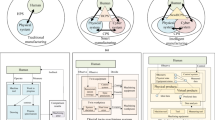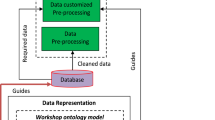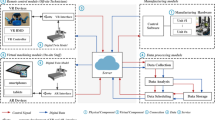Abstract
Modification of size, residual stress, and surface roughness have an enormous impact on a complex mechanical product’s final machining quality. Machine quality can be ensured using Digital Twin (DT) technology by checking the real-time machining process. The virtual–real separation display method is the most modern DT System (DTS). It results in the ineffective transmission of the necessary restricting the use of the DTS by processing data on-site technicians to support field processing. Augmented Reality (AR) monitoring the manufacturing process approach to solve this problem is proposed based on the DT. First, the dynamic multi-view for AR is built using data from multiple sources. Second, real-time monitoring of complex product’s intermediate processes incorporates AR to encourage communication between the users of the DT machining system. The outcome of the system can prevent errors that cannot be fixed. An application case for observing will be used to confirm the viability and the efficacy of the proposed method.






Similar content being viewed by others
References
Li M, Feng X, Han Y. Brillouin fiber optic sensors and mobile AR-based DTs for quantitative safety assessment of underground pipelines. Autom Constr. 2022;144: 104617.
Liu S, Lu S, Li J, Sun X, Lu Y, Bao J. Machining process-oriented monitoring method based on DT via AR. Int J Adv Manuf Technol. 2021;113(11):3491–508.
Zhang Z, Wen F, Sun Z, Guo X, He T, Lee C. Artificial intelligence-enabled sensing technologies in the 5G/internet of things era: from virtual reality/AR to the DT. Adv Intell Syst. 2022. https://doi.org/10.1002/aisy.202100228.
Yi L, Glatt M, Ehmsen S, Duan W, Aurich JC. Process monitoring of economic and environmental performance of a material extrusion printer using an AR-based DT. Addit Manuf. 2021;48: 102388.
Kikuchi N, Fukuda T, Yabuki N. Future landscape visualization using a city DT: integration of AR and drones with implementation of 3D model-based occlusion handling. J Comput Design Eng. 2022;9(2):837–56.
Vidal-Balea A, Blanco-Novoa O, Fraga-Lamas P, Vilar-Montesinos M, Fernández-Caramés TM. Collaborative Augmented DT: a novel open-source AR solution for training and maintenance processes in the shipyard of the future. Eng Proc. 2021;7(1):10.
Ssin S, Suh M, Lee J, Jung T, Woo W. Science tour and business model using DT-based AR. In: AR and Virtual Reality. Cham: Springer; 2021. p. 267–76.
Moya B, Badías A, Alfaro I, Chinesta F, Cueto E. DTs that learn and correct themselves. Int J Numer Meth Eng. 2022;123(13):3034–44.
Balamurugan K, Latchoumi TP, Ezhilarasi TP. Wearables to improve efficiency, productivity, and safety of operations. In: Smart manufacturing technologies for industry 4.0. Boca Raton: CRC Press; 2022. p. 75–90.
Künz A, Rosmann S, Loria E, Pirker J. The potential of augmented reality for digital twins: a literature review. In 2022 IEEE conference on virtual reality and 3D user interfaces (VR) 2022 (pp. 389-398). IEEE.
Yu C, Xu S. A DT-based AR assisted cloud additive manufacturing framework in support of value co-creation for multi-stakeholder. Available at SSRN 4210230. 2022.
Vidal-Balea A, Blanco-Novoa O, Fraga-Lamas P, Vilar-Montesinos M, Fernández-Caramés TM. A collaborative industrial AR DT: developing the future of shipyard 4.0. In: International Summit Smart City 360. Cham: Springer; 2022. p. 104–20.
Lyons N. Deep learning-based computer vision algorithms, immersive analytics and simulation software, and virtual reality modeling tools in DT-driven smart manufacturing. Econ Manag Financ Mark. 2022;17(2):67–81.
Anand M, Balaji N, Bharathiraja N, Antonidoss A. A controlled framework for reliable multicast routing protocol in mobile ad hoc network. Mater Today Proc. 2021. https://doi.org/10.1016/j.matpr.2020.10.902. (ISSN 2214-7853).
Jumani AK, Kumar K, Ameen Chhajro M. Systematic analysis of virtual reality & augmented reality. Int J Inf Eng Electron Bus. 2021;13(1):36–43.
He F, Ong SK, Nee AY. An integrated mobile AR DT monitoring system. Computers. 2021;10(8):99.
Jumani AK, Siddique WA, Abro A, Khan AA. Virtual reality and augmented reality for education. In: Multimedia computing systems and virtual reality. Boca Raton: CRC Press; 2022. p. 189–210.
Shahzad M, Shafiq MT, Douglas D, Kassem M. DTs in built environments: an investigation of the characteristics, applications, and challenges. Buildings. 2022;12(2):120.
Mihai S, Yaqoob M, Hung DV, Davis W, Towakel P, Raza M, Nguyen HX. DTs: a survey on enabling technologies, challenges, trends and future prospects. IEEE Commun Surv Tutorials. 2022. https://doi.org/10.1109/COMST.2022.3208773.
Wu K, Laghari RA, Ali M, Khan AA. A Review and State of Art of Internet of Things (IoT). Archives Comput Methods Eng. 2021;2021:1–19.
Latchoumi TP, Ezhilarasi TP, Balamurugan K. Bio-inspired weighed quantum particle swarm optimization and smooth support vector machine ensembles for identification of abnormalities in medical data. SN Appl Sci. 2019;1:1137. https://doi.org/10.1007/s42452-019-1179-8.
Liu YK, Ong SK, Nee AYC. State-of-the-art survey on DT implementations. Adv Manuf. 2022;10(1):1–23.
Khan AA, Laghari AA, Shaikh AA, Shaikh ZA, Jumani AK. 8 Innovation in multimedia using IoT systems. In: Multimedia computing systems and virtual reality. Boca Raton: CRC Press; 2022. p. 171.
Hasan SM, Lee K, Moon D, Kwon S, Jinwoo S, Lee S. AR and DT system for interaction with construction machinery. J Asian Archit Build Eng. 2022;21(2):564–74.
Garg G, Kuts V, Anbarjafari G. DT for fanuc robots: industrial robot programming and simulation using virtual reality. Sustainability. 2021;13(18):10336.
Lian B, Zhu Y, Branchaud D, Wang Y, Bales C, Bednarz T, Waite TD. Application of DTs for remote operation of membrane capacitive deionization (mCDI) systems. Desalination. 2022;525: 115482.
Caiza G, Sanz R. Digital twin for monitoring an industrial process using augmented reality. In 2022 17th Iberian Conference on Information Systems and Technologies (CISTI) 2022 (pp. 1-5). IEEE.
Jumani AK, Laghari RA. Review and state of art of fog computing. Arch Comput Methods Eng. 2021;2021:1–13.
Sierla S, Azangoo M, Rainio K, Papakonstantinou N, Fay A, Honkamaa P, Vyatkin V. Roadmap to semi-automatic generation of DTs for brownfield process plants. J Ind Inf Integr. 2022;27: 100282.
Sneha P, Balamurugan K. Investigation on wear characteristics of a PLA-14% bronze composite filament. In: Recent trends in product design and intelligent manufacturing systems. Singapore: Springer; 2023. p. 453–61.
Beisheim N, Rädle M, Reichwald J, Linde M, Otta T, Amann S, Kastner K. Simultaneous interdisciplinary teamwork on digital twins in a 3D collaborative environment. In Transdisciplinarity and the Future of Engineering, Proceedings of the 29th International Society of Transdisciplinary Engineering (ISTE) Global Conference, Cambridge, MA, USA, 5–8 2022 (pp. 380-389). Amsterdam, The Netherlands: IOS Press Incorporated.
Funding
The authors declare that no funding has been received to carry out the work.
Author information
Authors and Affiliations
Corresponding author
Ethics declarations
Conflict of interest
The authors declare that they have no conflict of interest.
Additional information
Publisher's Note
Springer Nature remains neutral with regard to jurisdictional claims in published maps and institutional affiliations.
This article is part of the topical collection “Research Trends in Communication and Network Technologies” guest edited by Anshul Verma, Pradeepika Verma and Kiran Kumar Pattanaik.
Rights and permissions
Springer Nature or its licensor (e.g. a society or other partner) holds exclusive rights to this article under a publishing agreement with the author(s) or other rightsholder(s); author self-archiving of the accepted manuscript version of this article is solely governed by the terms of such publishing agreement and applicable law.
About this article
Cite this article
Ashok, J., Kumar, N.A., Raj, D.W.P. et al. Design and Implementation of Smart Manufacturing Systems Through AR for Data-Driven Digital Twin System. SN COMPUT. SCI. 4, 580 (2023). https://doi.org/10.1007/s42979-023-01956-1
Received:
Accepted:
Published:
DOI: https://doi.org/10.1007/s42979-023-01956-1




